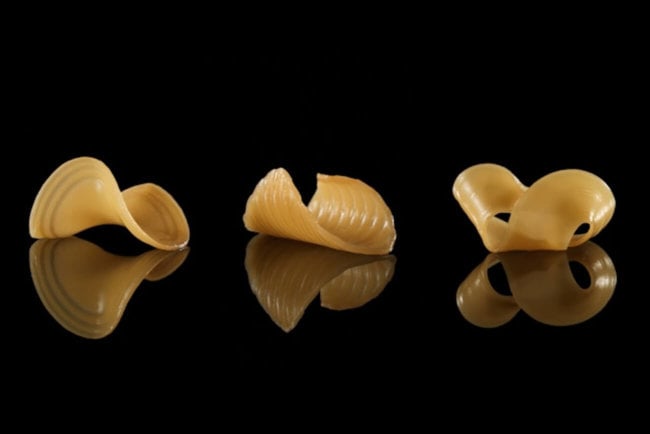
Scientists from the Massachusetts Institute of technology are engaged not only in developments in the field of robotics and electronics, but also in the field of modernization of the food industry. Not long ago, during a conference of the Association for computing machinery in Denver, they introduced a new type of paste, which can be “programmed” in such a way that when released into water the product will be able to take any form.
Of specially treated flat blanks you can get pasta in the form of bagels, spirals, shells and generally of any shape. Really strange at first glance, the invention has great prospects. It is now about 67% of the packaging, the pasta is air, and the use of mutable pasta will reduce the cost of packaging, delivery and costs in the manufacture, because each form does not need to be a separate production line.
The basis of the variable paste is two layers of gelatin with a different density — denser layer absorbs more moisture and stronger bends. On top of the gelatin applied strips of cellulose that moisture generally does not absorb. Depending on the location of all of the layers relative to each other, and the shape of the blank, when treated with water form the finished product may be very different. Moreover, the variability of forms you can use for cooking special dishes. As an example, the authors propose to place the rectangular sheets of pasta in the dish of water on the surface of which floats the eggs (or any other ingredient). During the process of folding, pasta “wrap” the eggs and end up with something like cannelloni — pasta with filling inside. The authors have released a whole demo video on its technology, and has also published step-by-step instructions for self-production of pasta:
- Prepare edible gelatin gel.
- If necessary, add food coloring or flavoring (squid ink, seaweed, and so on).
- Dry gelatin film air flow. Will suit even a hair dryer, but it will take about 12 hours.
- Apply to the dried gel using a 3D printer solution of cellulose.
- Almost ready to cut the pasta into pieces of the desired shape.
- Submerge the pasta in water heated to 30 degrees Celsius for 2 minutes.

MIT staff have learned “programming” pasta
Vladimir Kuznetsov